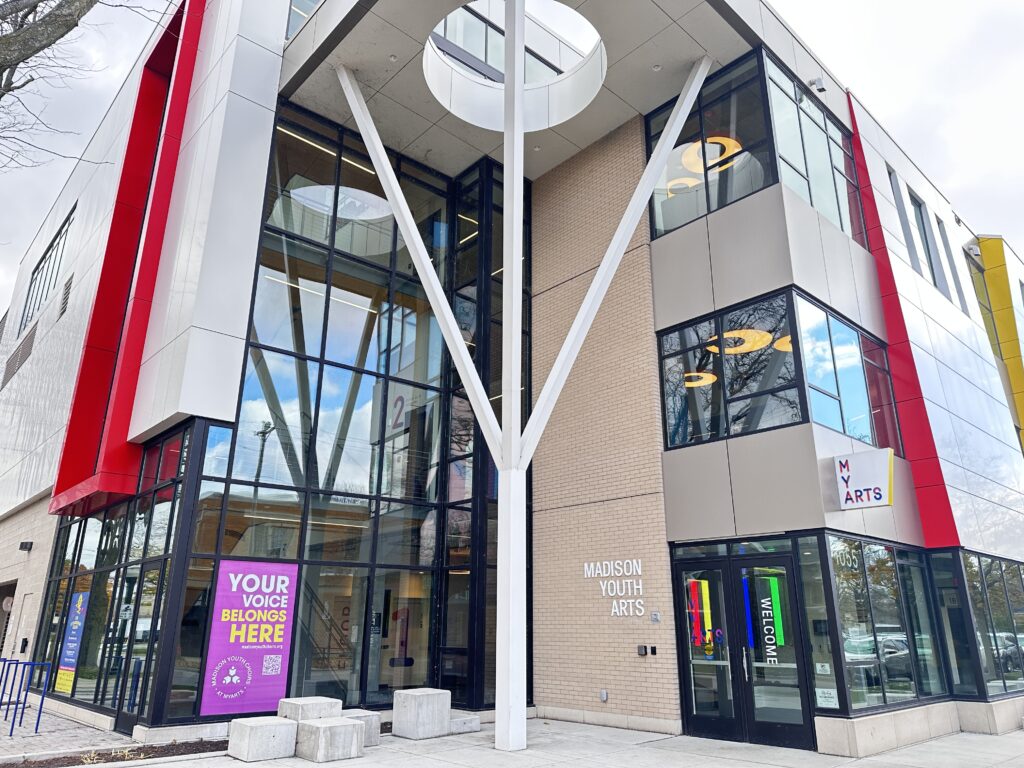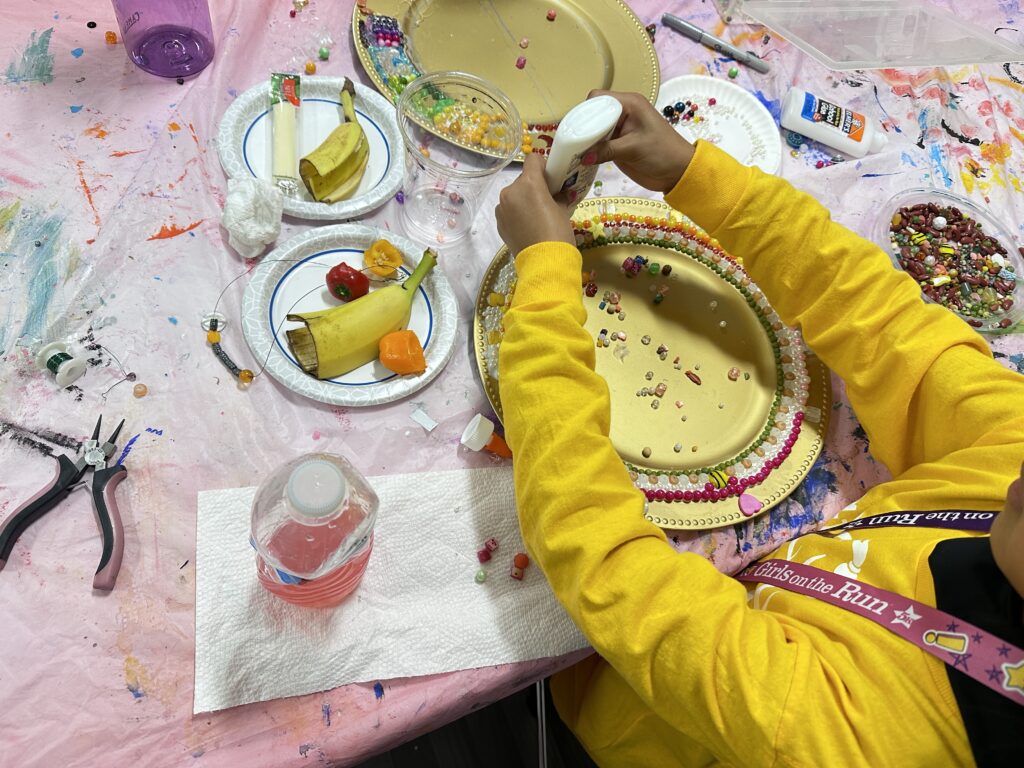Madison Youth Arts Center offers a canvas for children’s creativity
By: Eric Herbst, Omar Waheed and Wanruo Zhao

It’s a Saturday morning in November, and children in an art room at the Madison Youth Arts Center craft mirrors decorated with beans, pearls and glue.
Some children in the group — who were part of a program called Little Picassos — finished their designs quickly and creatively. Others finished half of their designs as class ended — mainly due to talking with their classmates. For instance, a girl named Maria happily talked with the girl next to her and just glued the beans and pearls on her plate without putting the mirror on.
Whether the children worked slowly or fast, the teachers were there to provide support, since the program encourages creativity and not competition.
A boy’s mother Nicolle who has been there for more than one year leaves good feedback about this course by connecting her kid with peers, gaining hands-on experience and staying away from mobile devices.
Leora Saposnik, who started Little Picassos eight years ago, feels it’s one of the best art programs in the city for children from low-income families because it provides access to high-quality art materials that are difficult for children to use at school.
“Our kids deserve to get to see themselves as artists,” Saposnik says. “It’s all about making our kids feel like they belong.”
The space where that happens is the Madison Youth Arts Center — called MYArts — at the corner of East Mifflin Street and North Ingersoll Street in downtown Madison. The location is fitting in a way, for just as its brick-and-glass visage lies at a crossroads, its interior also reflects the convergence and continuation of different paths. Here, creativity can be a spark that leads to life-long passion, and the center offers unique opportunities for youth and young adults to be creative in affordable, artistic ways.
Giving children space to belong and create in their own way at the Madison Youth Arts Center fuels artistry for the city’s youth by offering affordable, accessible niche programs. The center’s vast offerings give children the chance to express themselves and expand their horizons. By melding the intersections of affordable arts and education, the center aims to create positive outcomes for Madison’s youth later in their lives.
Research shows that having access to an arts education can set students up for success.
“All the ways in which we know and do in the arts are transferable to the ways we know and do in other kinds of disciplines,” says Erica Halverson, author of “How the Arts Can Save Education: Transforming Teaching, Learning, and Instruction” and an arts education professor at UW–Madison. “Art-making involves creating representation of ideas … and becoming good at making representations is what school is about.”
Center offers arts enrichment opportunities
Since it officially opened in spring 2021, the Madison Youth Arts Center has made a tangible impact within the local community, supporting more than 55 youth arts programs and offering more than 30,000 hours of programming. With two theaters, 14 studios and 65,000 square feet available, the center enriches children and teens across four creative pillars: visual arts, theater, dance and music. Combined, the center’s programs bring participants from every background together, offering an inclusive space where learning, imagination and creativity collide to great effect.
“The fact of having space at all, and having it be affordable and consistent, and designed for kids, actually solves a lot of problems for youth arts programs,” says Jessica Courtier, the center’s director of community partnerships. “It may seem simple from the outside, but being able to leave materials in a space versus having to carry them all the time — that solves the problem.”
The center’s affordability brings a unique opportunity for every child to have a chance to express themselves at MYArts. The center meets the growing needs of Madison by bringing unique offerings from different cultures around the world.
And, most important of all, this access to the arts shapes the education children receive.
“Engaging young people in arts practices is, first of all, joyful and collaborative and productive for them as an act in and of itself,” Halverson says.
Halverson has seen a systematic dismantling of access to arts education, but MYArts has been one of the organizations committed to combating the issue. Halverson also runs the Whoopensocker program at MYArts, an education residency that teaches creative writing and social-emotional skills through the theater.
“Why is making art for its own sake important for human flourishing,” Halverson says. “Arts organizations and teaching artists and artists in residence and educator activists have had to step in to create those opportunities where young people can bring their assets into an art-making situation and use their gifts to become members of productive arts communities.”
Children create and play in the classroom and on the stage
“Every child is an artist,” Pablo Picasso once said.
However, not every child has the same access to art education due to poverty and other circumstances. The Little Picassos program at the Madison Youth Arts Center offers free art space for children from low-income families to create and learn about art.
Before founding the program, Saposnik volunteered at The Road Home, an organization that helps homeless families find housing. While volunteering, it became clear to Saposnik many homeless children didn’t have access to art enrichment classes, since the art classes in the Madison area were mostly for white, upper-middle-class families.
Saposnik brought art supplies to The Road Home to solve the issue. After she saw how the children loved creating art, Saposnik spent three years writing grants for funding in support of a new arts program.
In 2015, the Little Picassos program was born.
A few years later, the program added bilingual options to its curriculum for English language learners, boosting access for Spanish-speaking families. When teacher Amelia Paulino, a native of Mexico, brought her kids to the center, Saposnik asked Paulino to join the team. Affordability remains a critical component of these classes.
“Those programs are the core of our mission,” Courtier says. “If you’re giving something away for free, you probably shouldn’t pay as much where you may not have the capacity to pay.”
The center doesn’t just cater to youth and teens in the visual arts. A big benefit of the center’s structure is the shared communal space for multiple artistic disciplines, granting pupils exposure to new art forms and ideas.
“A reachable goal is a kid comes [to the center] because they’re taking a Little Picassos class, and they see a bunch of theater kids and they go, ‘What’s that? I want to do that. How can I become part of that community?’” Halverson says. “Folks pick up one another’s ideas by being in the same area as them.”
The Madison Youth Art Center’s two theaters, named the Sunrise Theater and Starlight Theater, offer additional opportunities to enrich learners and budding artists. These participants come from a variety of backgrounds, with some having yet to perform on a proper stage.
“A lot of these groups we serve are disaffected communities,” says Jarrod Bainter, the center’s technical operations manager. “They’re used to performing in a high school gymnasium or perhaps a church basement, and the thing I hear more often than not is that it’s so great to give our students a real professional venue to perform in. That’s been really rewarding.”
Bainter joined the center in November 2022, serving as the contact person for the groups who use the theaters. He also maintains the stage technology equipment. Bainter sees the impact of the theater program on students firsthand.
“Sometimes when the students come in and they see this space they go, ‘Whoa, this is so cool,’” Bainter says. “When I show them the technology and what they get to play with, their eyes light up and they start to get creative.”
The lessons the two theaters provide participants are a small part of the center’s larger operations. Bainter sees this mission at work everywhere at the center, from drum circles to dance recitals to everything in between.
“With all of our classrooms and the two different theaters sometimes we’ll have four or five events going on at the same time,” Bainter says. “It’s another rewarding aspect to see the building used how it was supposed to be — a home for all kinds of different arts, all kinds of different groups, all at one time.”

Music makes Madison move
There are thousands of different dances found across the world, and the center tries to facilitate as many as it can to combine movement and music.
Twelve classes and groups are offered that merge movement, dance, music and world cultures. From ballet; Japanese traditional dances; capoeira, an Afro-Brazilian martial art and dance that involves aerobics and music; and general recreation to promote creativity, the center facilitates community interests with one of the few dedicated dance spaces in Madison.
“There have been an awful lot of youth arts programs that have been working out of spaces that weren’t great for one reason or another,” Courtier says. “That’s in part because there’s not a lot of dance studio space available in our community.”
The center is always focused around youth experiences, and its leaders work to make its classes as affordable as possible for both kids and the niche interest dance classes. For some children that might mean financial assistance. For dance classes for groups without their own studio, it comes in the form of a sliding scale payment and a place to store any necessary equipment.
Groups like Drum Power, a West African, Afro-Brazilian and Afro-Cuban drum and dance group, run classes to promote creativity, culture and leadership. The program melds together music and movement to give a cohesive cultural experience for children at the center.
“West African dance, understanding the rhythmic pattern of the drumming, is one of the ways in which people understand literally what moves they’re supposed to do, because those things are tied together,” Courtier says.
Drum Power holds regular classes throughout the year, along with its newer Inaugural Day of Drum through the center, when it gives a day of classes out to the larger community after its summer arts camp.
Paving the way for access to all, from dance, music, theater and visual arts, holds priority of the center’s mission to provide the city’s youth with as many paths to creativity as possible. At its core, the center tries to help programs, like Drum Power, have the space to bring its programming to Madison’s youth. The center hopes that its affordability will trickle down to students.
“Some of the groups we work with just flat out don’t charge anything at all,” Courtier says. “That’s where we put our resources because, of course, anytime a group doesn’t pay market rate, which truly no youth art group does pay, then it’s on us to make up the cost difference.”